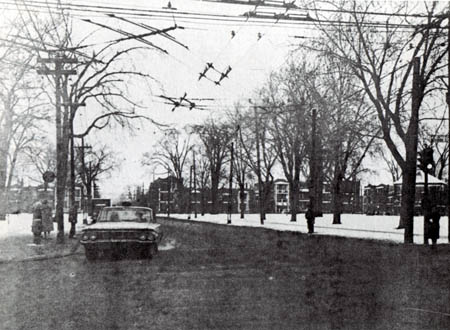From Monthly Film Bulletin, December 1976 (Vol. 43, No. 515). — J.R.
One Second in Montreal
Canada, 1969
Director: Michael Snow
Dist–London Filmmakers’ Co-op/Cinegate. p.c /p/ph/ed–Michael Snow. 612 ft. (at 16 f.p.s.) 26 mins.; (at 24 f .p.s.) 17 mins.
A series of thirty-odd black and white still photographs – all showing park sites for a projected monument in Montreal covered with blankets of snow — are rephotographed and shown in succession; the duration of each photograph on the screen progressively increases during the first section of the film, and progressively decreases during the second, which ends with a ‘flash’ repeat of the initial title card. A simple experiment in what might be described as the phenomenology of duration in relation to the viewer’s attention and grasp of detail, One Second in Montreal apparently owes its title to the fact that the combined exposure time of the original photographs adds up to only one second.
Praised somewhat hyperbolically as a “cinematic construction which plays upon the seriality of film images” (Annette Michelson) and a “snow film so silent you can hear the snow fall” (Jonas Mekas), the film is an ‘open’ work in the sense that it can be projected at either 16 or 24 frames per second. While the issues of duration and ‘legibility’ that it raises are important and complex ones — particularly in relation to the use of still photographs (which Chris Marker’s La Jetée has explored quite differently, within a narrative framework) — the bareness, nondescript banality and minimal thematic or compositional interest of the images, made all the less alluring by their bleached-out appearance, at least in the print under review) renders the investigation of this problem a rather monotonous and joyless experience under the present circumstances.
Standard Time
Canada, 1967
Director: Michael Snow
Dist–London Filmmakers’ Co-op/Cinegate. p.c/p/ph–Michael Snow. In colour. ed/sd–Michael Snow with—Joyce Wieland. 288 ft. 8 mins. (16 mm.).
The camera pans round various parts of a room — past a hi-fi set, cabinets, TV, refrigerator, wall space, etc. — while a man’s voice (and later a woman’s) discussing “audience involvement or reaction” fades in and out; the pans vary in speed and length, and the separate shots, occasionally separated by jump cuts, often begin or end with a motionless camera. Initially the physical terrain is sufficiently static to suggest that the pans are — or might just as well be –- moving across an extended still photograph, until a human figure suddenly moves at the end of one left-to-right trajectory. Afterwards, the camera pans in a vertical axis from ceiling to floor, by-passing Joyce Wieland on a bed and a turtle crawling across the floor, until it reaches the legs of the camera’s tripod. By this time the sound has shifted to a radio, and when the camera darts past Wieland again in subsequent horizontal pans (which find her in other parts of the room), the radio is heard being switched to different stations. Asked to describe Standard Time in a l97l interview in Take One, Michael Snow replied, “I don’t know. Thinking about Wavelength made me think about using other kinds of basic film vocabulary things. And that was like a sketch that showed a lot of possibilities. It’s my home movie, really”. An honest enough account of a smattering of unsustained ideas, Snow’s description significantly places more emphasis on objects (“things”) than on processes, and it might be argued that his mature films concentrate chiefly on the latter. Here one can vaguely discern ‘rough drafts’ for certain processes which take more rigorous shape in later films, from the horizontal and vertical pans of Back and Forth to the functions of an off-screen radio in Breakfast. But the isolation of these processes from one another and their relatively unpolished execution in Standard Time suggest something closer to an artist’s palette than to a finished canvas.


